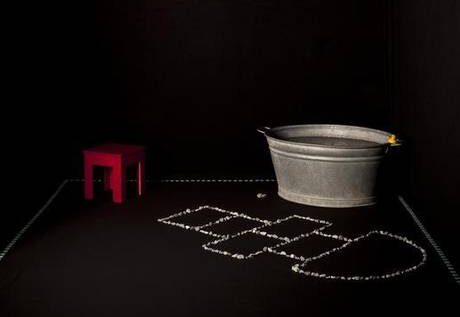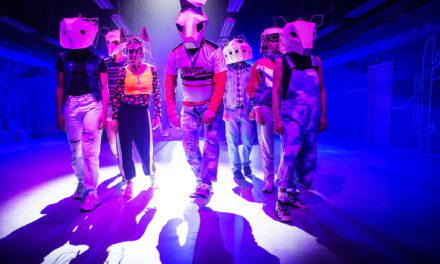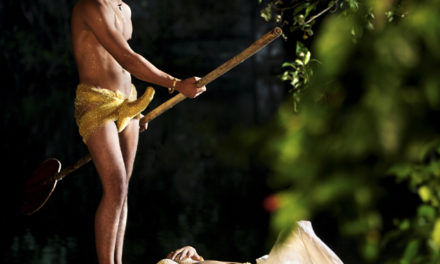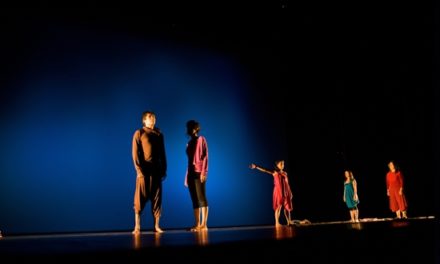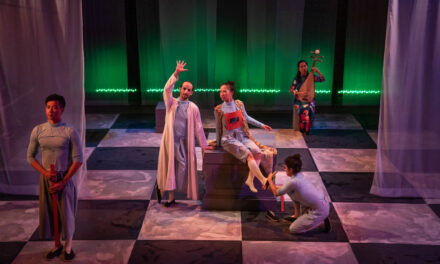I am inside a dark room, saved by a lone light and a single stool. On one side is a curtain, but every other side seems to be closed. It feels as though I am trapped inside one of those giant pieces of a jigsaw puzzle. Not knowing what to expect next, I wait when a heavily accented voice that is clear and composed greets me through my headphones. She will be my guide from this point on. Earlier outside, I was strictly asked to follow the voice blindly. I have absolutely no intention to get lost in this carefully curated maze that Swiss company Trickster P has created in Goethe-Institut to retell Hansel and Gretel, but with all its flaws. I leave my shoes as instructed and move on from the first room.
1…2.. knock on the door.
I listen to voices of children, playing in wild abandon as I sit by the bath (a steel tub filled with water with a yellow duck on one of its edges), in front of neatly arranged pebbles. I imagine them to be holding hands. The story has begun, the voice tells me. She asks me to sit on a tiny stool in the corner of the same room, and reflect on this “fairytale”, a story of hunger and poverty; of home and exile; of the brittle link between childhood and adulthood; of loneliness; and also invites me to be part of the journey.
By now, I am in no fear of not comprehending the heavily accented words — I have started to live the tale. I move on to another room, in the center of which stands a light bulb stuck on a pole surrounded by benches. The voice asks me to make myself comfortable and I sit, only to be blinded by the light. She asks me to listen: muffled voices take over but I am not able to make out what they are saying. The voice prods me to move into the next room; a cross-section of a wooden house, a small cellar. Here, Hansel whispers to me that it’s time to leave, to run away. And off we go to the woods. The floor is ridden with tiny tree-like objects, faintly illuminated from underneath; a path is laid out. It’s time for me to switch my little torch on — I find my way out as the voice reminisces about how Hansel and Gretel got lost in the woods, in terse, short excerpts from the story. Upon reaching the end of the path, through a hole in the black wall, I see a sharp light in a distance — it looks like a house (a miniature structure is cleverly set up at the end of the room). I catch a whiff of gingerbread as I enter the next room — a sturdy, large gingerbread house stands tall in front of me. After a few sniffs and touches, I confirm that the house is indeed made of gingerbread.
The voice asks me to enter the house and I do, only to be mildly terrified at the first sight of what lies inside. Bones, of all shapes and sizes, are meticulously arranged along the sides. The mild stench of flesh and blood hangs in the air (or at least, the voice makes me believe so). She asks me to take a brief moment there. The next room takes me closer to the witch — with two feet projected on a television screen on the ground and a small cage hung from above. The shadow of the cage that falls on the wall, making it appear larger-than-life. The voice tells me that it’s time to push the witch into the oven and Hansel and Gretel join in. “As she bends over, we push her inside and close the door.” Crackling noises follow as the witch bellows in agony… The screams echo in my ear.
I move on, into the penultimate room which houses everything that symbolizes death — dentures, a shoe, and perforated nails take the eeriness a notch higher. At that moment, the voice tells me that I have woken up from this terrible dream and guides me out.
I am back where I started, only my shoe now holds a white pebble.
This article was originally published in The Hindu by Gowri S. on September 30, 2019, and has been reposted with permission.
This post was written by the author in their personal capacity.The opinions expressed in this article are the author’s own and do not reflect the view of The Theatre Times, their staff or collaborators.
This post was written by Gowri S.
The views expressed here belong to the author and do not necessarily reflect our views and opinions.

